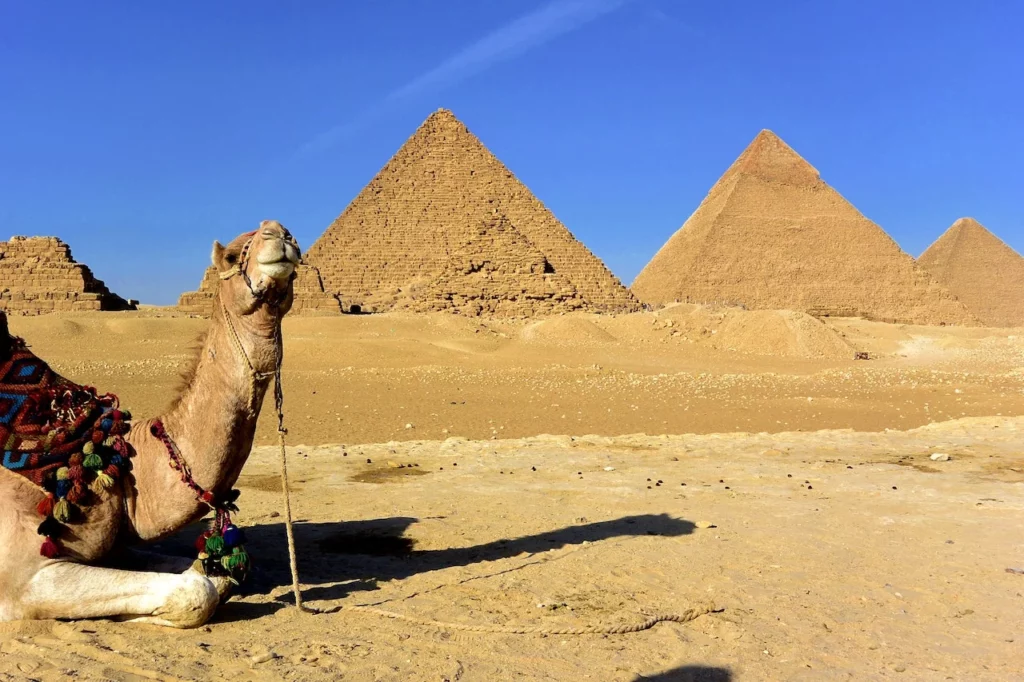Enchanting Egypt: The Land of Pyramids, Pharaohs, and More
Welcome to Egypt, a country that captivates travelers with its extraordinary blend of ancient wonders, vibrant culture, and breathtaking landscapes. In this article, we invite you to delve into the enchanting world of Egypt, where majestic pyramids, legendary pharaohs, and a myriad of fascinating attractions await. Whether you are an adventurer seeking historic treasures, a culture enthusiast craving immersive experiences, or simply a traveler eager to explore a land of remarkable allure, Egypt guarantees to leave you awe-inspired.
Ancient Egypt: A Glimpse into the Past
The civilization of ancient Egypt, which thrived along the banks of the Nile River, offers a captivating glimpse into the past. With a history stretching back over 5,000 years, this remarkable civilization left behind a legacy that continues to amaze and intrigue us today.
The Birth of Ancient Egypt
- The rise of ancient Egypt dates back to the Neolithic period, around 6000 BCE.
- The Nile River played a crucial role in the development and sustainability of the civilization.
The Unification of Upper and Lower Egypt
- Around 3100 BCE, King Narmer unified Upper and Lower Egypt, creating the first dynasty and establishing the capital city of Memphis.
- This marked the beginning of the legendary pharaonic dynasties that ruled Egypt for centuries.
Hieroglyphics: The Ancient Egyptian Writing System
- One of the most remarkable accomplishments of ancient Egypt was the development of hieroglyphics, a complex writing system consisting of pictorial symbols.
- Hieroglyphics were used for religious texts, administrative records, and monumental inscriptions.

Religion and Beliefs
- Ancient Egyptians were deeply religious, and their beliefs revolved around the worship of numerous gods and goddesses.
- The pharaohs were considered divine and acted as intermediaries between the gods and the people.
The Great Pyramids of Giza
- The iconic pyramids of Giza, built during the Old Kingdom period, stand as a testament to the ancient Egyptians’ architectural prowess.
- The largest pyramid, the Great Pyramid of Khufu, is one of the Seven Wonders of the Ancient World.
Life and Society in Ancient Egypt
- Ancient Egyptian society was structured hierarchically, with pharaohs at the top, followed by the nobles, priests, scribes, artisans, and farmers.
- The majority of the population consisted of farmers who worked to sustain the kingdom.
Achievements in Agriculture and Technology
- The ancient Egyptians developed sophisticated agricultural techniques, such as irrigation systems and the use of the Nile’s annual flood.
- They also made advancements in technology, including the construction of monumental structures and intricate jewelry.
Art and Architecture
- Ancient Egyptian art and architecture are renowned for their grandeur and meticulous craftsmanship.
- Temples, tombs, statues, and paintings were all intricately designed and often depicted scenes from daily life or religious rituals.
Burial Practices and the Afterlife
- Ancient Egyptians believed in the afterlife and invested immense resources into ensuring a prosperous journey to the “Land of the Dead.”
- Elaborate tombs, such as the Valley of the Kings, were constructed to house the pharaohs and preserve their bodies.
Decline and Legacy
- Despite its long and prosperous reign, ancient Egypt eventually declined due to various factors, including foreign invasions and internal strife.
- However, its cultural, religious, artistic, and architectural contributions continue to influence and inspire the world to this day.
Unraveling the Mysteries: Pyramids and Monuments
The pyramids and monuments of ancient Egypt stand as a testament to the remarkable achievements and ingenuity of this ancient civilization. Each structure holds its own mysteries and captivates the imagination with its grandeur and historical significance.
The Great Pyramids of Giza
- The Great Pyramids, located on the outskirts of Cairo, are the most iconic symbols of ancient Egypt.
- Built as monumental tombs for pharaohs, these pyramids were constructed with precise engineering and astonishing precision.
- The Great Pyramid of Khufu, the largest of the pyramids, is a marvel of ancient architecture and an enduring mystery.
The Sphinx: Guardian of Giza
- Adjacent to the pyramids stands the Sphinx, an awe-inspiring statue with the body of a lion and the face of a pharaoh.
- Carved from a single block of limestone, the Sphinx has fascinated scholars and visitors alike for centuries.
- The purpose and identity of the Sphinx remain subjects of debate and speculation, adding to its enigmatic allure.
The Pyramid Complexes
- The pyramids were not standalone structures but part of larger complexes that included mortuary temples, causeways, and smaller satellite pyramids.
- These complexes were designed to facilitate the religious rituals and cults surrounding the pharaohs’ burials.
- Exploring these complexes offers insights into the religious beliefs and practices of ancient Egypt.
Pyramid Texts and Funerary Practices
- Inside the pyramids, intricate hieroglyphic texts known as the Pyramid Texts were inscribed on the walls.
- These texts contained spells, hymns, and instructions to guide the deceased pharaohs in their journey to the afterlife.
- The elaborate funerary practices of ancient Egypt reflected their belief in the continuity of life beyond death.
The Great Sphinx: Guardian of Giza
The Great Sphinx, standing majestically on the Giza Plateau, is an enduring symbol of ancient Egypt. This colossal statue, with its enigmatic expression, guards the entrance to the Giza Necropolis and captivates visitors with its imposing presence.
The Origin and Purpose of the Sphinx
- Believed to have been built during the reign of Pharaoh Khafre in the 26th century BCE, the Sphinx was originally known as “Horus in the Horizon.”
- The purpose of the Sphinx is still a subject of debate among Egyptologists, with theories ranging from being a guardian figure to a symbol of divine power.
The Marvels of Sphinx’s Construction
- Carved from a single limestone outcrop, the Sphinx measures 73 meters long and stands 20 meters tall.
- The precision and craftsmanship involved in its construction are astounding, with intricate details sculpted to represent a pharaoh, most likely Khafre.
Theories and Legends Surrounding the Sphinx
- The Sphinx has sparked numerous theories and legends throughout history, creating an aura of mystery and intrigue.
- Some theories suggest that the Sphinx originally had a different head, possibly that of Pharaoh Khafre, while others propose connections to ancient civilizations or even extraterrestrial influences.
Restoration and Conservation Efforts
- Over the years, the Sphinx has faced erosion and weathering due to natural elements and human activity.
- Restoration and conservation efforts have been undertaken to preserve this iconic monument, including measures to protect it from rising groundwater levels.
Step Back in Time: Exploring Luxor and the Valley of the Kings
Luxor, known as Thebes in ancient times, is a veritable treasure trove of archaeological wonders. Located in southern Egypt, this historical city offers a unique opportunity to step back in time and explore the captivating Valley of the Kings.
Luxor: The World’s Greatest Open-Air Museum
- Luxor is often referred to as the “world’s greatest open-air museum” due to its abundance of ancient temples, tombs, and monumental structures.
- Visitors can explore the Karnak Temple Complex, one of the largest temple complexes in the world, and marvel at its colossal statues, obelisks, and sanctuaries.
The Valley of the Kings
- Located on the west bank of the Nile, the Valley of the Kings served as the burial place for pharaohs and nobles of the New Kingdom period.
- This necropolis houses intricately decorated tombs, such as the famous tomb of Tutankhamun, offering a glimpse into the afterlife beliefs and funerary practices of ancient Egypt.
Exploring the Tombs
- Visitors can explore several tombs in the Valley of the Kings, each with its own unique decorations and hieroglyphic texts.
- The walls of these tombs depict scenes from the Book of the Dead, providing
An Epic Journey: Nile River Cruises
A Nile River cruise takes you on a voyage down this legendary river, allowing you to witness the wonders of Egypt from a unique perspective. The journey typically starts in Cairo, the bustling capital city, where you can explore the ancient pyramids of Giza and the iconic Sphinx before boarding your luxury river cruise ship.
As you sail down the Nile, you will travel through the heart of ancient Egypt, passing by historic sites and stunning landscapes. One of the highlights of the journey is a visit to Luxor, known as the world’s greatest open-air museum. Here, you can explore the famous Valley of the Kings, where pharaohs were buried, and the impressive Karnak and Luxor temples.
Continuing your journey, you will reach Edfu and Kom Ombo, two cities home to well-preserved temples dedicated to powerful gods Horus and Sobek. These temples offer a glimpse into the religious beliefs and architectural marvels of ancient Egyptians.
Another must-see destination along the Nile is Aswan, located at the southernmost point of Egypt. Here, you can visit the majestic Aswan High Dam and experience the serenity of the Philae Temple, dedicated to the goddess Isis. The picturesque island of Elephantine, with its Nubian village and charming atmosphere, is also a popular stop on Nile River cruises.
Throughout your journey, you will be mesmerized by the ever-changing landscapes that line the banks of the Nile. From lush green fields and palm groves to ancient ruins and desert vistas, the scenery is as diverse as the rich history of the region.
On board your luxury cruise ship, you can indulge in world-class amenities and services while enjoying the majestic views from your balcony or the sundeck. Fine dining, cultural performances, and enriching lectures about Egyptian history and culture are just some of the experiences that await you.
A Nile River cruise is not just a vacation; it is an opportunity to immerse yourself in the wonders of ancient Egypt and uncover the mysteries of this fascinating civilization. With each passing day, you will feel the weight of history and the sheer magnitude of the Nile’s importance to the development of human civilization.
The Marvels of Cairo: A Vibrant Modern City with Ancient Roots
The bustling capital city of Cairo is a vibrant metropolis that seamlessly blends the old and the new. With its ancient roots dating back to the Pharaonic era, Cairo offers an incredible mix of historical sites, modern attractions, and a thriving local culture.
One of the marvels of Cairo is the Giza Plateau, home to the iconic Great Pyramids of Giza and the mysterious Sphinx. These ancient wonders stand as a testament to the engineering prowess of the ancient Egyptians and continue to inspire awe and wonder in visitors from around the world.
Cairo is also home to an array of world-class museums and artifacts that showcase Egypt’s rich cultural heritage. The Egyptian Museum in Tahrir Square is a treasure trove of ancient artifacts, including the dazzling treasures of King Tutankhamun. From statues and mummies to intricate jewelry and hieroglyphic inscriptions, the museum offers a mesmerizing journey through Egypt’s past.
For lovers of Islamic art and architecture, a visit to the Citadel of Cairo is a must. This medieval fortress houses beautiful mosques, including the stunning Muhammad Ali Mosque, and offers panoramic views of the city from its elevated position.
To truly immerse yourself in the local culture, a visit to Cairo’s souks is a must. Wander through the narrow alleys of Khan el Khalili, one of the oldest markets in the world, and experience the vibrant atmosphere as you browse through colorful stalls selling spices, textiles, jewelry, and handicrafts. Don’t forget to haggle and try some delicious local street food while you’re at it!
Beyond the historical and cultural attractions, Cairo also offers a thriving modern scene. Explore the bustling neighborhoods of Zamalek and Maadi, where you can find trendy cafes, art galleries, and boutique shops. For a taste of Cairo’s vibrant nightlife, head to Downtown Cairo or the upscale district of Zamalek, where you’ll find an array of trendy bars, clubs, and live music venues.
Cairo truly encompasses the essence of Egypt, with its ancient wonders, rich cultural heritage, and modern vibrancy. Whether you’re exploring the iconic pyramids, strolling through bustling markets, or indulging in the city’s culinary delights, Cairo offers a captivating experience that will leave you in awe of its past and inspired by its present.
Egypt’s Rich Cultural Heritage: Museums and Artifacts
Egypt’s rich cultural heritage is best experienced through its museums and artifacts. From ancient pharaonic treasures to Islamic art and Coptic artifacts, Egypt’s museums offer a glimpse into the country’s fascinating history and diverse cultural influences.
The Egyptian Museum in Cairo is a must-visit for any history enthusiast. Located in Tahrir Square, this world-renowned museum houses an extensive collection of artifacts, including the iconic treasures of Tutankhamun, such as his golden death mask and elaborate sarcophagi. The museum also showcases a vast array of statues, mummies, papyrus scrolls, and intricate jewelry, providing visitors with a comprehensive view of ancient Egypt.
Another notable museum is the Nubian Museum in Aswan, which focuses on the rich heritage of the Nubian people. Here, you can learn about their history, traditions, and unique cultural artifacts. The museum also displays the salvaged archaeological artifacts that were moved during the construction of the Aswan High Dam.
For those interested in Islamic art and architecture, the Islamic Art Museum in Cairo is a treasure trove. With its diverse collection of textiles, woodwork, ceramics, and metalwork, the museum showcases the beauty and intricacy of Islamic craftsmanship throughout the centuries.

Immerse in Egyptian Souks: Vibrant Markets and Local Delights
Immersing yourself in Egyptian souks, or markets is another way to experience the country’s vibrant culture and local delights. The Khan el Khalili market in Cairo is a bustling maze of narrow alleyways filled with an array of shops selling everything from spices and textiles to handcrafted souvenirs. Take your time to explore the market, soak in the vibrant atmosphere, and interact with friendly shopkeepers.
In Aswan, the Nubian Souk is a must-visit for a more authentic and local experience. Here, you can find a variety of Nubian handicrafts, such as colorful textiles, pottery, and traditional jewelry. Don’t forget to savor the local cuisine, such as spicy kebabs, freshly baked bread, and sweet pastries, which you can find in the bustling food markets within the souks.
Exploring the museums and souks of Egypt allows you to delve deep into its cultural heritage, from ancient times to the present day. From marveling at pharaonic artifacts to haggling for unique souvenirs, these experiences offer a dynamic and immersive journey into the vibrant culture of Egypt.
Heavenly Beaches and Red Sea Adventures
Egypt is not just known for its ancient history and cultural treasures; it is also home to stunning beaches and exciting Red Sea adventures. Along the country’s coastline, you’ll find heavenly beaches with crystal-clear waters and vibrant marine life, making it a paradise for water sports enthusiasts and beach lovers.
Sharm El Sheikh is one of Egypt’s most popular beach destinations, offering a variety of luxurious resorts and awe-inspiring dive sites. The clear turquoise waters of the Red Sea provide excellent visibility for snorkeling and scuba diving, giving you the opportunity to explore vibrant coral reefs teeming with colorful fish and other marine species. Whether you’re a beginner or an experienced diver, the Red Sea’s underwater world will leave you mesmerized.
Hurghada is another coastal gem known for its beautiful beaches and vibrant nightlife. This resort town offers a mix of relaxation and adventure, with opportunities for snorkeling, windsurfing, and even desert safaris. Dive into the warm waters and uncover the wonders of the Red Sea, or simply unwind on the golden sands and soak up the sun.
Acknowledging the Spiritual Side: Religious Sights of Egypt
Beyond the coastal areas, Egypt is also a destination for acknowledging the spiritual side with its religious sites. The religious sights of Egypt offer a glimpse into the country’s deep-rooted history and its significance as a melting pot of cultures and beliefs.
In Cairo, the historic heart of Islamic Cairo is home to several breathtaking mosques, including the beautiful Al-Azhar Mosque and the striking Sultan Hassan Mosque. These architectural marvels not only represent Islamic art and culture but also serve as important centers for worship and learning.
In Old Cairo, you’ll find the Coptic Quarter, which is home to important Christian landmarks. Visit the Hanging Church (Saint Virgin Mary’s Coptic Orthodox Church) and explore the Coptic Museum, which houses an extensive collection of Coptic art and artifacts.
Incredible Oasis Escapes: Serenity amidst the Desert
Egypt is also home to incredible oasis escapes, offering a serene retreat amidst the desert expanse. The Siwa Oasis, located in the western part of the country, is one of the most secluded and enchanting oases in Egypt. Surrounded by stunning sand dunes and natural springs, Siwa offers a peaceful atmosphere and unique cultural experiences. Explore the ancient ruins of the Temple of the Oracle, take a dip in the healing waters of Cleopatra’s Bath, or simply relax and enjoy the tranquility of the surroundings.
The Bahariya Oasis and the White Desert are other popular desert destinations that offer a blend of adventure and natural beauty. Go on a camel ride, venture into the desert on a 4×4 safari, or spend the night under the starry sky, engulfed in the silence and tranquility of the desert.
Egypt’s heavenly beaches, Red Sea adventures, religious sights, and serene oasis escapes offer a diverse range of experiences for travelers. Whether you seek an adrenaline-fueled adventure, a spiritual journey, or a peaceful retreat, Egypt has something to offer for every kind of traveler.
Diving into History: Ancient Egyptian Temples
Egypt is home to some of the most magnificent ancient temples in the world, showcasing the architectural brilliance and religious significance of the ancient Egyptians. Exploring these temples is like stepping back in time, offering a glimpse into the rich history and cultural heritage of Egypt.
The Karnak Temple Complex in Luxor is one of the largest and most impressive temple complexes in Egypt. It is dedicated to the gods Amun, Mut, and Khonsu. Walk through the colossal columns, marvel at the intricate hieroglyphics, and imagine the grandeur of the rituals and ceremonies that took place here thousands of years ago.
The Temple of Abu Simbel, located near the southern border of Egypt, is another must-visit site. This temple was built by Pharaoh Ramses II and is known for its stunning rock-cut statues guarding the entrance. The temple was relocated in the 1960s to save it from being submerged in Lake Nasser during the construction of the Aswan High Dam.
The Temple of Hatshepsut, located on the west bank of the Nile near Luxor, is dedicated to the only female pharaoh of Egypt. This elegant temple features impressive terraces, statues, and colorful reliefs that depict the reign of Hatshepsut.
Other notable temples include the Temple of Luxor, the Temple of Edfu, and the Temple of Kom Ombo. Each temple has its own unique characteristics and historical significance, offering a fascinating journey through ancient Egyptian civilization.
Mouthwatering Egyptian Cuisine: A Gastronomic Delight
Egyptian cuisine is a delightful fusion of flavors, influenced by its long history and vibrant culture. From aromatic spices to mouthwatering street food, exploring Egyptian cuisine is a must for food lovers.
One iconic dish to try is koshari, a hearty vegetarian dish made with rice, lentils, macaroni, and chickpeas, and topped with a tangy tomato sauce and crispy fried onions. It’s a true comfort food and a favorite among locals.
Falafel, made from ground chickpeas or fava beans, is a popular street food snack. These deep-fried balls of goodness are best enjoyed on warm pita bread with a variety of toppings and sauces.
Another dish to savor is ful medames, a traditional Egyptian breakfast made from slow-cooked fava beans, flavored with garlic, lemon juice, and olive oil. It’s often enjoyed with fresh bread and is a healthy and satisfying way to start the day.
For meat lovers, don’t miss out on trying kofta, which is flavorful, grilled minced meat skewers typically made from beef or lamb. They are often served with rice, grilled vegetables, and a side of creamy tahini sauce.
To satisfy your sweet tooth, indulge in delicious Egyptian desserts like baklava, a delectable pastry made with layers of phyllo dough filled with nuts and sweet honey syrup. Basbousa, a semolina cake soaked in a fragrant sugar syrup, is another dessert worth trying.
Festivals and Celebrations: Experience Egyptian Joie de Vivre
Egyptians are known for their love of celebrations and festivals, which provide a vibrant showcase of their culture, traditions, and religious rituals.
One of the most significant festivals in Egypt is Ramadan, the holy month of fasting for Muslims. During this time, the streets come alive with colorful lights and vibrant decorations, and in the evenings, families and friends gather for festive meals known as Iftar, marking the end of the daily fast.
Eid al-Fitr, which marks the end of Ramadan, is another joyous celebration in Egypt. Families come together to exchange gifts, enjoy special meals, and visit friends and relatives. Festive processions and fireworks can be seen throughout the country.
Sham El Nessim is an ancient Egyptian spring festival celebrated on the Monday following Coptic Easter. It involves spending the day outdoors, picnicking, and enjoying the beauty of nature. It is a time for families and friends to come together and have a good time.
- When visiting religious sites and temples, it’s important to dress modestly and respectfully, covering your shoulders and knees.
- It’s advisable to carry small denominations of Egyptian pounds for tipping and purchasing small items, as change can sometimes be difficult to obtain.
- Bargaining is a common practice in markets and souks, so don’t be afraid to negotiate prices. However, do so politely and with a friendly attitude.
- It’s recommended to drink bottled water or purified water and avoid consuming tap water to prevent any chance of getting sick.
- Egypt experiences high temperatures throughout the year, so wearing lightweight, breathable clothing and staying hydrated is essential.
- Respect local customs and traditions, especially during religious festivals or when visiting more conservative areas.
- It’s a good idea to learn a few basic Arabic phrases, as it can greatly enhance your experience and facilitate communication with locals.

Conclusion
Egypt, a land of pyramids, pharaohs, and countless wonders, awaits your exploration. From the awe-inspiring monuments of Giza and the ancient temples of Luxor to the vibrant streets of Cairo and the enchanting oases in the desert, Egypt offers an enchanting journey through time. Immerse yourself in its rich history, vibrant culture, and breathtaking landscapes, and let the magic of Egypt leave an indelible mark on your soul.
Also Read:



